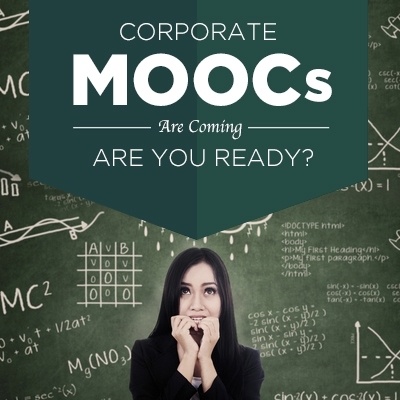Benefits And Drawbacks Of A Corporate MOOC
There are endless philosophical discussions about the benefit of formal exams. It is said that they teach students by rote without passing on knowledge or skills. Or that they produce robots who follow instructions, rather than intellectuals who can think critically. Instead, some say, we should promote education for its own sake, not just to pass tests. This is the premise behind a corporate MOOC. These unpaid eLearning courses allow online learners to study whatever they want, whenever they want, with no exam pressure. Let’s look at some benefits and downsides of this approach in the corporate eLearning sector.
The Good: Lower Cost
MOOCs are free. There’s no tuition fee, and because corporate learners can study wherever they want, there’s no commute. The learning material is often available as pre-recorded lectures, in audio or video format. There may be a book list attached, and many of these titles are available online. Your corporate learners could also borrow reference texts from libraries, or your organization can foot the bill. Which may still be more cost-effective than launching a full online training program in-house. For an employee, all they need is time and internet access. For an organization, it costs nothing, short of supplemental online training resources you may need to provide.
The Bad: Lower Customization Options
On the other hand, if you pick a corporate MOOC for your employees, you can’t brand its content or layout. You could go through available MOOCs and select those that are relevant to your industry. But beyond that, there’s no way to tweak their use case. Along the same vein, many of these MOOCs are offered by academic institutions. Their online training material, by definition, isn’t always applicable to the workplace. It could boost esteem and work-life balance, but it’s unlikely to offer practical job tools. This is one of the primary reasons why organizations choose to develop their own online training courses, as this allows them to align the online training content with their brand image and L&D gaps.
The Good: Freely Available
Ordinarily, getting into university is a gargantuan task. It gets even harder for Ivy League schools like Yale, Harvard, Brown, or Oxford. Aside from the cost and potential visa requirements, competition is intense. With a corporate MOOC, anyone can learn. You don’t even have to apply. Just pick the online training course you want, fire up your device, and go. You don’t need any special skills or educational qualifications. If you can read, type, and use a computer, tablet, or phone, you’re ready. You can even print out the online training material and study in hard copy. As such, organizations are able to recommend relevant MOOCs to employees with specific skill, knowledge, or performance gaps. For example, a sales associate who is struggling to hit their targets might benefit from a negotiation skills online training course.
The Bad: Free For All
In essence, this means your knowledge won’t be exclusive. Anyone can study the same material, so you won’t have an edge or acquire a unique skill. Also, some MOOCs aren’t accredited, even though they’re offered by accredited institutions. They’re often simplified versions of the original course. And because there’s often no exam, test, or gauge, there’s no objective measure of knowledge transfer. You can’t tell if the corporate MOOC really ‘taught’ you anything, and there’s no certification to prove you studied. This is in stark contrast to in-house online training programs, which often involve measurable LMS metrics.
The Good: Flexible Time-Wise
Courses in a MOOC set-up are often uploaded as a whole. You have all the online training material available, and you can learn in your own time. And because the online training material is available in multiple formats, you can study where and how you want. Watch a video clip as you wait in line for coffee. Listen to a lecture as you clean your house. There are no limits and no expectations. You picked a subject that interests you, and you study just because you want to. You’re more likely to enjoy yourself, since it’s all about the pleasure of learning. As a result, employees can fit online training into their schedules without having to worry about interfering with their work duties.
The Ugly: Low Learner Engagement And Lack Of Personalization
Unfortunately, all that flexibility has a dark side. While some MOOCs do have in-built quizzes, nothing will happen if you ‘fail’. With no pressure, finals, or formal guidance, many employees leave their online training courses incomplete. It’s not even a conscious decision. They just forget to finish. There are no carrots or sticks, no consequences. And because much of the online training material is simplified, it may not be compelling enough to drive completion. The lack of personalization means that many corporate learners won’t find relevance in the content. It may brush over the subject matter, but not tie into their everyday lives or work duties. It’s generic, instead of catering to their individual goals, preferences, and roles.
MOOCs offered at iTunes U, Open U, MIT, Harvard, and other top institutions are trending. These MOOCs seem to solve all the problems of traditional learning, such as lower cost, lower pressure, and lower negative peer influence. The pros of these virtual courses include free tuition, flexibility, versatility, and free-form learning. On the negative spectrum, many of these MOOCs are academic, so they’re not profitable for corporates. They may not bring many benefits to office settings, have a high drop-off rate, and don’t issue valid documentation, such as an online degree, diploma, or certificate. Plus, they can’t be tailored to fit your brand.
Still wondering whether MOOCs for corporate learning are worth the investment? Read the article 6 Benefits Of Using MOOCs For Corporate Training to learn the about most notable benefits of MOOCs for corporate training.








